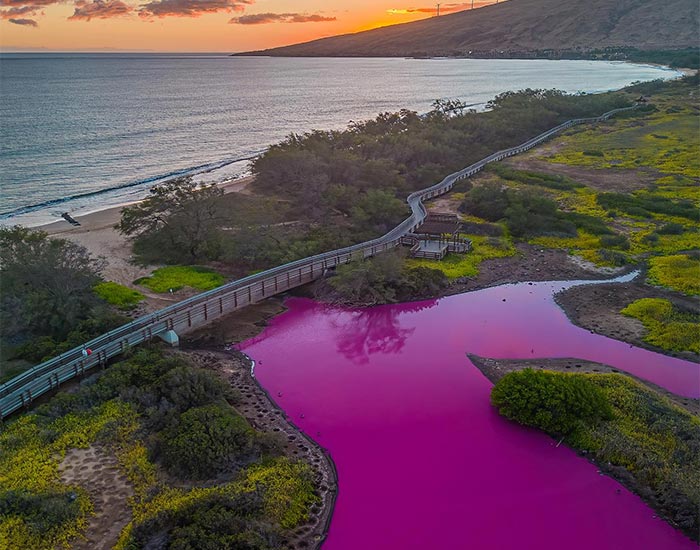While it may look like an enchanted land or some sort of Barbie-themed park, the Kealia Pond National Wildlife Refuge in Maui, Hawaii, isn’t as majestic as its appearance might lead you to believe.
The Hawaiian pond has undergone a puzzling transformation, adopting a vibrant pink hue that has left scientists expressing concerns about this unusual phenomenon.
Since images of the colored pond surfaced on social media, inquisitive observers have been drawn to the site.
The Kealia Pond National Wildlife Refuge in Maui, Hawaii, has turned pink, baffling people working at the reservation
Image credits: traviskeahi_photos
Image credits: traviskeahi_photos
Volunteers at the Kealia Pond National Wildlife Refuge on Maui, some with a seven-decade history around the water, assert that they have never encountered anything quite like this before.
Bret Wolfe, the refuge manager, received initial notification from an individual walking along the beach who informed him “There’s something weird going on over here,” as reported by Sky News.
The prevailing drought in Maui is posited by scientists as a potential cause
View this post on Instagram
However aesthetically captivating it may appear, authorities are expressing concerns that the pond’s pink transformation could be indicative of more troubling circumstances.
The prevailing drought in Maui is posited by scientists as a potential cause.
While toxic algae was initially considered a suspect, laboratory tests ruled it out as the reason for the unusual coloration.
Instead, attention is now directed towards a microorganism known as halobacteria.
Halobacteria, classified as a type of archaea or single-celled organism, flourish in bodies of water with elevated salt levels.
Experts have also point to a microorganism known as halobacteria as the root cause for the spectacular color
Image credits: homeonmaui
Presently, the salinity within the Kealia Pond outlet area is reportedly double that of seawater.
Despite the pond having experienced periods of both drought and heightened salinity in the past, the reason for the recent change in color remains an enigma, according to Bret.
Further analysis through DNA testing is required to definitively identify the source of this transformation.
Visitors are cautioned against entering the water or consuming any fish caught from the pond during the ongoing investigation into its cause.
You can watch the unique-looking pond below
View this post on Instagram
As surprising as it seems, pink natural water resources are not a completely extraordinary phenomenon.
Australia is home to at least seven pink lakes: Lake Hillier, Lake Eyre, Lake Bumbunga, Lake MacDonnell, and Lake Hartthe.
According to Science, the bubblegum color comes from the unique blend of the microorganisms present, including dunaliella salina, an algae that thrives in high salt concentration and in turn produces beta carotene, giving it a reddish-pink hue, as well as the halobacteria.
Other pink lakes have been located in three regions of Africa, six regions in Asia, and even five European regions, including in France.

 Dark Mode
Dark Mode 

 No fees, cancel anytime
No fees, cancel anytime 






























































46
10